wine street
wine street
Formerly Grope Lane
Wine Street was originally called Grope Lane and was referred to as such as early as 1341 and in 1415 was referred to as 'Gropelane' in a deed thus "Conveyance by Thomas Harlyng, parson of the church of Yevele and lord of that town, to John Syly, Matilda his wife, and John their son, for their lives, of a messuage and curtilage in Yevele, in the street called 'Gropelane'; the grantees to build a new house upon the premises within the next six years &c. Eve of Whitsunday, 2 Henry V". It was still named Grope Lane on E Watts' map of 1806 (see below).
It has been said that, rather than today’s lewd association, the name possibly derived from the fact that one had to feel one’s way, or grope around, after dark in this narrow little lane as it wound its way from the Borough to South Street before Peter Daniell built Union Street. Indeed, until the 1830’s with the coming of Bond Street (also built by Peter Daniell), Grope Lane was the only direct access for a cart from High Street, the Borough and Middle Street to South Street - George Court and Tabernacle Lane being too narrow for a cart.
Having said that, it cannot be denied that in medieval times it was common for many English towns to have a Gropec*nt Lane where ladies of the night plied their trade, since it was normal practice for a medieval street name to reflect the street's function or the economic activity taking place within it. The earliest known use of Gropec*nt (albeit not in Yeovil) is in about 1230 and streets with that name were often in the busiest parts of medieval towns and cities. Although the name was once common throughout England, changes in attitude resulted in its replacement by more innocuous versions such as Grape Lane or, in Yeovil's case, shortened to Grope Lane and finally changed to Wine Street during the nineteenth century.
In the early part of the nineteenth century much of the northern side of the northern part of the Wine Street dog-leg was taken up by a lumber yard owned by Robert Jennings, the Silver Street ironmonger who was Portreeve in 1827-37 and Postmaster.
After Union Street came into being, probably in the 1830’s, the lower part of Wine Street remained named as such until at least the late 1870’s before becoming the southern half of Union Street.
The name Wine Street entered use from at least 1831 and derives from the wine and spirits shop of Watts, Thomas Bullock & Co on the site later occupied by the Wine Vaults. Watts, Thomas Bullock and Co were advertising as Wine & Spirit Dealers in Pigot’s 1824 Yeovil Trade Directory but within a couple of years the business was being run by James Male who continued until the Foan family took over from about 1850 until the 1890’s. Although it may have been possible to consume wine, spirits and even beer on the premises, it was probably only after this that the Wine Vaults became a public house in the accepted sense.
In Victorian times Wine Street was famous for the number of pubs standing cheek-by-jowl along its length; Sun Inn, Case is Altered, Royal Oak (later renamed the Hole in the Wall and now the Green Room), Full Moon, Running Horse, Bunch of Grapes and, of course, the Wine Vaults. There were also at least two un-named beerhouses. Now that’s what I call a beer crawl.
MAP
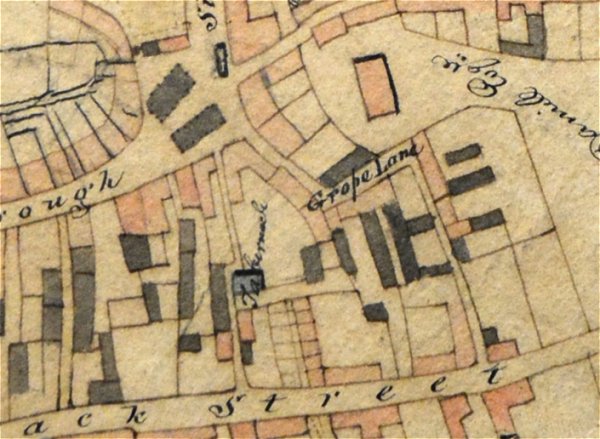
E Watts' map of 1806 shows Grope Lane running from the Borough to Back Street.
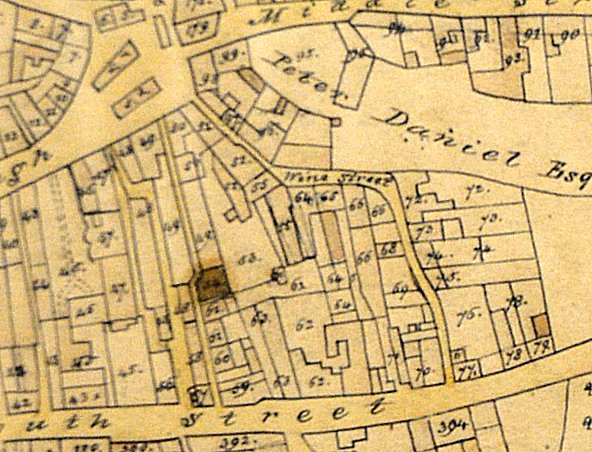
E Watts' map of 1831 shows Grope Lane now known as Wine Street and Back Street now called South Street.
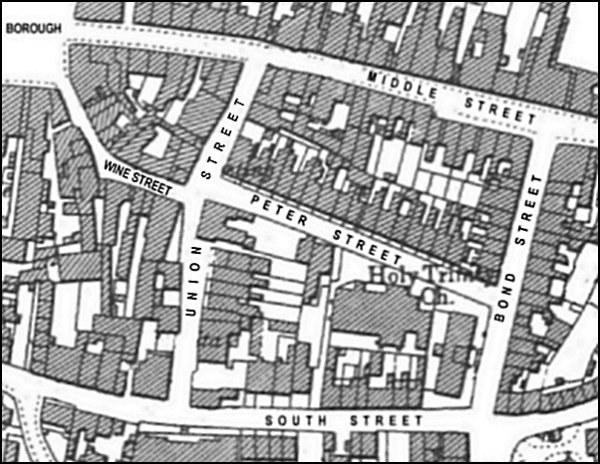
Map based on the 1901 Ordnance Survey showing Wine Street running from the Borough to Union Street. Originally Wine Street ran all the way to South Street as Union Street only came into existence in the 1830's and it wasn't until the 1870's that the southern half of Wine Street was renamed Union Street. The northern part of Union Street, Bond Street and Peter Street were all built by Peter Daniell - he named Peter Street after himself.
gallery
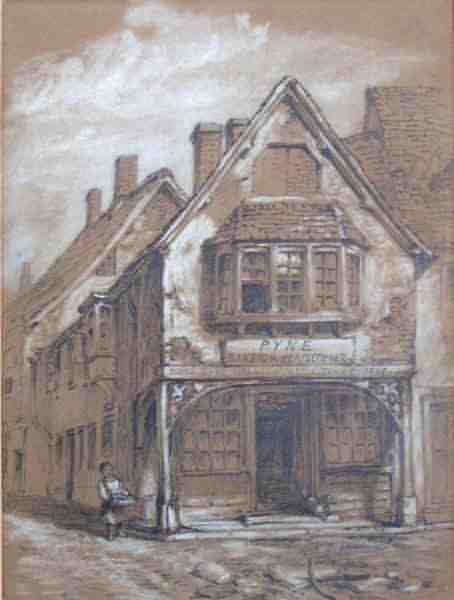
From my
collection
An original pastel and pencil sketch on paper (255mm x 190mm) of Charles Pyne's establishment 'Under Bow', showing part of the Wine Street elevation at left. The sketch is by artist Walter Francis Tiffin (1819-1890) of Salisbury, Wiltshire - although at the time of this sketch he was in Sherborne. An attached label reads "Sherborne, W Tiffin, 1865" and a second label, in pencil, reads 'By W F Tiffin'.
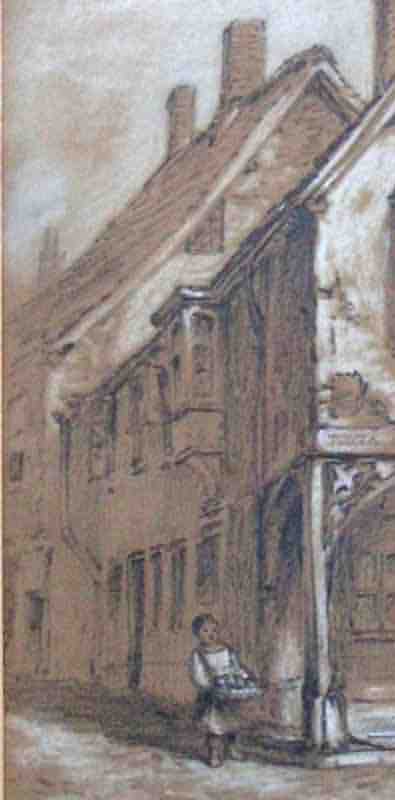
From my
collection
An enlargement of the previous image, looking down Wine Street from the Borough. The building known as Under Bow was destroyed by fire in 1861 and finally demolished within the following two years. Its removal allowed for the width of Wine Street to almost double to today's width.
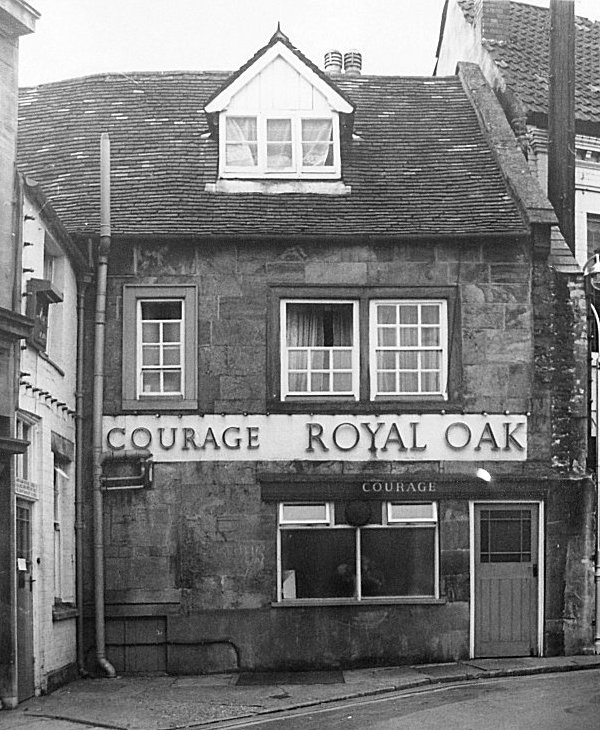
The Royal Oak, later the Hole in the Wall and today the Green Room. The only old building remaining in Wine Street and it still has a sixteenth century cellar. Photographed in the 1960's.
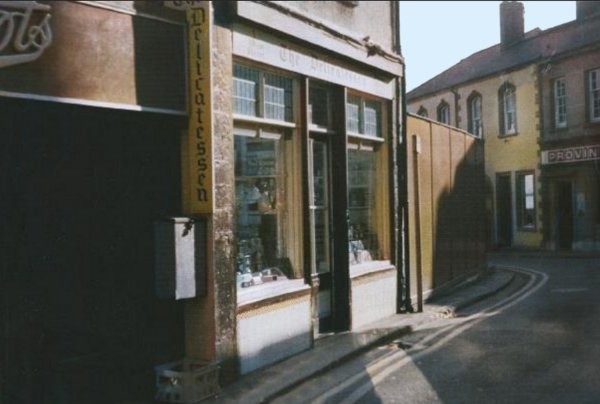
Courtesy of
Chris Symes
In 1973, Tom and Ivy Symes purchased Child's Dairy Delicatessen in Wine Street and opened The Delicatessen in Wine Street, in a colourised photograph of around 1974 (the beige building in the background is the Wine Vaults).
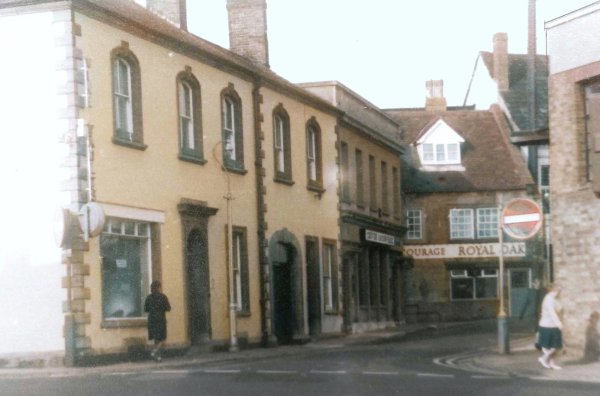
Wine Street, seen from Peter Street in the 1960s. Originally (before Union Street was constructed in the 1830s), Wine Street continued to the left as far as South Street.